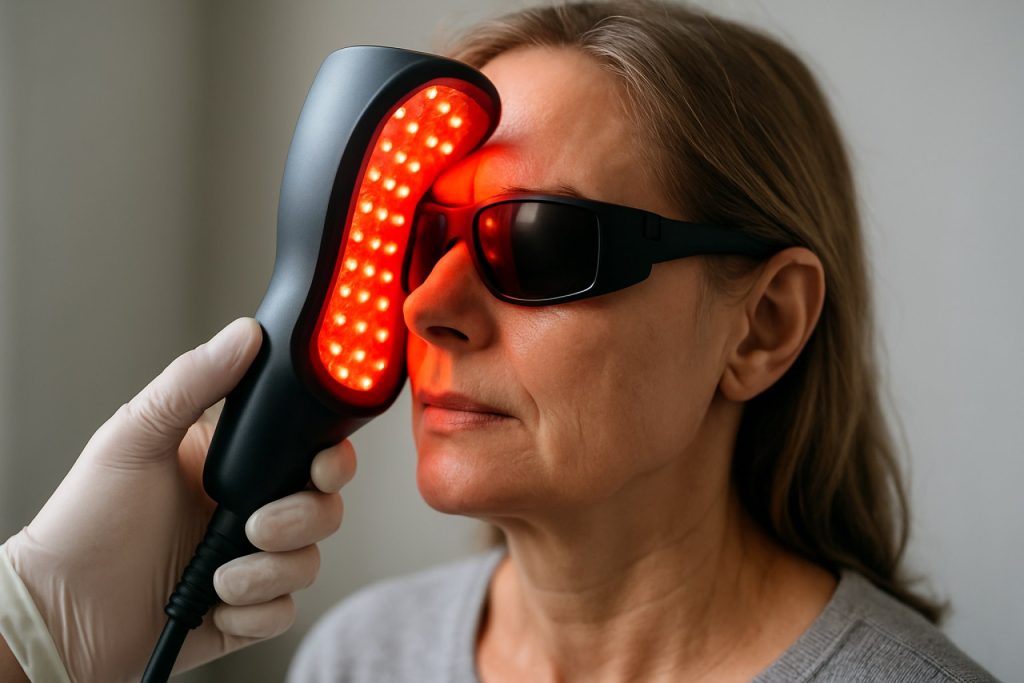
Optical Photobiomodulation Therapy Devices in 2025: Unveiling Rapid Growth, Technological Advances, and the Future of Non-Invasive Healing. Discover How This Sector is Shaping Healthcare Innovation Over the Next Five Years.
- Executive Summary: Key Trends and 2025 Market Snapshot
- Market Size, Growth Rate, and 2025–2030 Forecasts
- Core Technologies: LEDs, Lasers, and Device Innovations
- Therapeutic Applications: From Pain Management to Neurological Disorders
- Regulatory Landscape and Global Standards (e.g., FDA, IEC)
- Competitive Analysis: Leading Manufacturers and Emerging Players
- Adoption Drivers: Clinical Evidence and Patient Demand
- Challenges: Reimbursement, Awareness, and Technical Barriers
- Regional Insights: North America, Europe, Asia-Pacific, and Beyond
- Future Outlook: Disruptive Trends, R&D Pipelines, and Market Opportunities
- Sources & References
Executive Summary: Key Trends and 2025 Market Snapshot
Optical photobiomodulation therapy (PBMT) devices, which utilize specific wavelengths of light to stimulate cellular processes and promote tissue repair, are experiencing significant momentum in 2025. The sector is characterized by rapid technological innovation, expanding clinical applications, and increasing regulatory clarity. These trends are driving both the adoption of PBMT devices in medical and consumer wellness settings and the entry of new players into the market.
A key trend in 2025 is the diversification of device formats and wavelengths. Leading manufacturers such as Meditech International (BioFlex Laser), Erchonia Corporation, and Biolight Technologies are introducing devices that offer multi-wavelength capabilities, portable designs, and user-friendly interfaces. These innovations are making PBMT more accessible for both clinical professionals and home users. For example, Erchonia Corporation has expanded its FDA-cleared product line to address pain management, wound healing, and even non-invasive body contouring, reflecting the broadening scope of PBMT applications.
Regulatory progress is another defining feature of the current landscape. The U.S. Food and Drug Administration (FDA) and European regulatory bodies have granted clearances for an increasing number of PBMT devices, particularly for indications such as musculoskeletal pain, inflammation, and hair regrowth. This regulatory clarity is fostering greater confidence among healthcare providers and accelerating device adoption in physical therapy, sports medicine, dentistry, and dermatology.
Market data for 2025 indicates robust growth, with North America and Europe leading in adoption, but Asia-Pacific markets—especially China and Japan—showing rapid uptake due to rising healthcare investments and consumer interest in non-pharmacological therapies. Companies like Meditech International and Biolight Technologies are actively expanding their distribution networks and forming partnerships with healthcare institutions to capture these emerging opportunities.
Looking ahead, the outlook for optical photobiomodulation therapy devices remains highly positive. Ongoing clinical research, increasing public awareness, and the integration of digital health features—such as app-based treatment tracking—are expected to further drive market expansion. As more evidence emerges supporting the efficacy and safety of PBMT, the sector is poised for continued innovation and broader acceptance across both medical and consumer wellness domains.
Market Size, Growth Rate, and 2025–2030 Forecasts
The global market for optical photobiomodulation (PBM) therapy devices is poised for robust growth through 2025 and into the latter part of the decade, driven by expanding clinical applications, technological advancements, and increasing acceptance in both medical and consumer wellness sectors. PBM devices, which utilize specific wavelengths of light to stimulate cellular processes, are being adopted for a range of indications including pain management, wound healing, dermatological conditions, and neurological disorders.
As of 2025, the market is characterized by a diverse array of device types, including handheld lasers, LED panels, and wearable systems. Leading manufacturers such as BioFlex Laser, Erchonia Corporation, and THOR Photomedicine have established strong global footprints, supplying devices to clinics, hospitals, and home users. BioFlex Laser is notable for its multi-wavelength systems targeting musculoskeletal and neurological conditions, while Erchonia Corporation has pioneered FDA-cleared low-level laser devices for pain and inflammation. THOR Photomedicine is recognized for its research-driven approach and collaborations with academic institutions.
The market’s expansion is underpinned by a growing body of clinical evidence supporting PBM’s efficacy and safety, which has led to increased regulatory clearances in North America, Europe, and Asia-Pacific. For example, Erchonia Corporation has received multiple FDA clearances for its devices in the treatment of chronic pain and post-surgical recovery. Similarly, BioFlex Laser and THOR Photomedicine have reported significant adoption in physiotherapy and sports medicine.
Looking ahead to 2030, the market is expected to maintain a strong compound annual growth rate (CAGR), with estimates from industry participants and device manufacturers suggesting annual growth in the high single digits to low double digits. This outlook is supported by ongoing innovation in device miniaturization, integration of digital health features, and the expansion of home-use PBM products. Companies such as BioFlex Laser and THOR Photomedicine are investing in R&D to develop next-generation devices with enhanced efficacy, user interfaces, and connectivity.
In summary, the optical photobiomodulation therapy device market is set for sustained growth through 2025 and beyond, propelled by technological progress, regulatory support, and broadening clinical acceptance. The competitive landscape will likely see further innovation and strategic partnerships as established players and new entrants vie for market share in both professional and consumer segments.
Core Technologies: LEDs, Lasers, and Device Innovations
Optical photobiomodulation therapy (PBMT) devices leverage light-emitting diodes (LEDs) and lasers to deliver targeted wavelengths of light for therapeutic effects, such as reducing inflammation, accelerating tissue repair, and alleviating pain. As of 2025, the sector is witnessing rapid technological advancements, with a focus on improving efficacy, safety, and user experience.
LED-based PBMT devices have become increasingly prevalent due to their safety profile, cost-effectiveness, and ability to cover larger treatment areas. Companies like Meditech International and Theradome are recognized for their LED systems, which are widely used in clinical and home settings for applications ranging from musculoskeletal pain to hair regrowth. LEDs offer the advantage of emitting non-coherent light at specific wavelengths, typically in the red and near-infrared spectrum (600–1100 nm), which are optimal for tissue penetration and cellular response.
Laser-based PBMT devices, on the other hand, utilize coherent light sources, often providing higher power densities and more precise targeting. Erchonia Corporation and K-Laser are among the leading manufacturers of medical-grade laser PBMT systems. These devices are commonly used in rehabilitation clinics and sports medicine for their ability to deliver controlled doses of energy to deep tissues, supporting faster recovery and pain management.
Recent years have seen a convergence of LED and laser technologies, with hybrid devices emerging to combine the broad coverage of LEDs with the focused intensity of lasers. Innovations in device design include wearable and flexible PBMT systems, such as those developed by LumiWave, which allow for hands-free, continuous therapy and improved patient compliance. Additionally, integration of smart sensors and wireless connectivity is enabling real-time monitoring and personalized treatment protocols, a trend expected to accelerate through 2025 and beyond.
Looking ahead, the PBMT device market is poised for further growth, driven by ongoing clinical validation, regulatory approvals, and expanding indications. Companies are investing in miniaturization, battery efficiency, and user-friendly interfaces to cater to both professional and consumer markets. As the evidence base for PBMT continues to strengthen, adoption in mainstream healthcare and wellness is anticipated to rise, with leading manufacturers such as Meditech International, Erchonia Corporation, and K-Laser at the forefront of innovation.
Therapeutic Applications: From Pain Management to Neurological Disorders
Optical photobiomodulation therapy (PBMT) devices are increasingly recognized for their versatility in treating a broad spectrum of medical conditions, with a particular focus on pain management and neurological disorders. As of 2025, the therapeutic landscape is witnessing a surge in both clinical adoption and technological innovation, driven by growing evidence supporting the efficacy and safety of PBMT.
In pain management, PBMT devices utilize specific wavelengths of light—typically in the red and near-infrared spectrum—to modulate cellular activity, reduce inflammation, and promote tissue repair. Leading manufacturers such as BioFlex Laser and Biolight Technologies have developed systems tailored for musculoskeletal pain, arthritis, and sports injuries. These devices are increasingly used in physiotherapy clinics and rehabilitation centers, with ongoing studies indicating significant reductions in pain scores and improved functional outcomes for patients with chronic and acute pain conditions.
The application of PBMT in neurological disorders is a rapidly evolving frontier. Devices from companies like Vielight are being investigated for their potential to enhance cognitive function and slow the progression of neurodegenerative diseases such as Alzheimer’s and Parkinson’s. Clinical trials and pilot studies are underway, exploring transcranial photobiomodulation as a non-invasive adjunct to conventional therapies. Early results suggest improvements in memory, attention, and mood, fueling optimism for broader clinical integration in the coming years.
Beyond pain and neurology, PBMT devices are also being explored for wound healing, oral mucositis, and dermatological conditions. THOR Photomedicine is notable for its portable and clinical-grade devices, which are used in dental practices and oncology settings to manage treatment-induced side effects. The company collaborates with healthcare providers to expand the evidence base and refine treatment protocols.
Looking ahead, the next few years are expected to bring further advancements in device miniaturization, user-friendly interfaces, and integration with digital health platforms. Regulatory approvals are anticipated to expand, particularly as more robust clinical data emerges. Industry leaders are investing in education and training to support wider adoption among healthcare professionals. As the therapeutic applications of PBMT continue to diversify, the sector is poised for sustained growth, with a strong emphasis on evidence-based practice and patient-centered care.
Regulatory Landscape and Global Standards (e.g., FDA, IEC)
The regulatory landscape for optical photobiomodulation (PBM) therapy devices is evolving rapidly as the technology gains traction in medical, dental, and consumer wellness sectors. In 2025, regulatory agencies and standards organizations are focusing on ensuring device safety, efficacy, and quality, while also adapting to the increasing diversity of PBM applications.
In the United States, the Food and Drug Administration (FDA) continues to play a central role in the oversight of PBM devices. Most PBM devices are regulated as Class II medical devices, requiring premarket notification (510(k)) to demonstrate substantial equivalence to a legally marketed predicate device. The FDA evaluates parameters such as wavelength, power output, and intended use, and has cleared devices for indications including pain management, wound healing, and hair regrowth. Notable manufacturers with FDA-cleared PBM devices include BioFlex Laser, Erchonia Corporation, and THOR Photomedicine. These companies have established a track record of compliance with FDA requirements and are actively involved in ongoing clinical research to expand approved indications.
Globally, the International Electrotechnical Commission (IEC) sets harmonized safety and performance standards for medical electrical equipment, including PBM devices. The IEC 60601 series, particularly IEC 60601-2-57, specifies requirements for non-laser light therapy equipment. Compliance with IEC standards is often a prerequisite for market access in the European Union, where the Medical Device Regulation (MDR 2017/745) has tightened requirements for clinical evidence, post-market surveillance, and risk management. Companies such as biolitec AG and BIOLASE, Inc. are prominent in the European market, emphasizing adherence to both IEC and MDR frameworks.
In Asia-Pacific, regulatory pathways are diverse. Japan’s Pharmaceuticals and Medical Devices Agency (PMDA) and China’s National Medical Products Administration (NMPA) have established their own device registration processes, often referencing international standards. Leading regional manufacturers, such as Panasonic Corporation, are increasingly aligning their PBM device portfolios with global standards to facilitate international distribution.
Looking ahead, the regulatory outlook for PBM devices is expected to become more stringent and harmonized. Authorities are likely to introduce updated guidance on clinical endpoints, device labeling, and cybersecurity, reflecting the integration of digital health features. Industry bodies, including the MedTech Europe, are advocating for clearer pathways and international convergence to support innovation while safeguarding patient safety. As PBM technology matures, ongoing collaboration between manufacturers, regulators, and standards organizations will be critical to ensure responsible growth and global market access.
Competitive Analysis: Leading Manufacturers and Emerging Players
The competitive landscape for optical photobiomodulation therapy devices in 2025 is characterized by a blend of established medical device manufacturers and a dynamic cohort of emerging innovators. The sector is driven by increasing clinical adoption, expanding regulatory clearances, and a growing body of evidence supporting the efficacy of photobiomodulation (PBM) in pain management, wound healing, and neurological applications.
Among the global leaders, Meditech International Inc. (BioFlex Laser) stands out for its comprehensive range of PBM systems targeting both clinical and home-use markets. The company’s devices are widely used in physiotherapy, sports medicine, and rehabilitation, with ongoing investments in R&D to enhance device portability and treatment protocols. Another major player, Erchonia Corporation, is recognized for its low-level laser therapy (LLLT) devices, which have received multiple FDA clearances for indications such as chronic pain and post-surgical recovery. Erchonia’s focus on clinical validation and practitioner education has solidified its position in North America and Europe.
In Europe, BTL Industries is a significant manufacturer, offering a portfolio of laser and light-based therapy devices for musculoskeletal and aesthetic applications. BTL’s emphasis on ergonomic design and user-friendly interfaces has facilitated adoption in outpatient and home settings. Meanwhile, Theradome Inc. specializes in wearable PBM helmets for hair regrowth, leveraging proprietary laser technology and direct-to-consumer distribution channels.
Emerging players are increasingly shaping the competitive dynamics. K-Laser (Eltech K-Laser S.r.l.) has gained traction with its high-power, multi-wavelength laser systems, targeting veterinary, dental, and human medical markets. The company’s focus on modularity and software-driven customization appeals to practitioners seeking tailored treatment options. LED Technologies, Inc. is another notable entrant, offering FDA-cleared LED-based PBM devices for pain relief and skin rejuvenation, with a strong presence in retail and telehealth channels.
Looking ahead, the competitive outlook is expected to intensify as more companies pursue regulatory approvals for new indications and expand into emerging markets in Asia-Pacific and Latin America. Strategic partnerships between device manufacturers and healthcare providers are anticipated to accelerate clinical integration and broaden patient access. Additionally, advances in miniaturization, wireless connectivity, and AI-driven treatment personalization are likely to differentiate next-generation PBM devices, fostering both competition and innovation in the sector.
Adoption Drivers: Clinical Evidence and Patient Demand
The adoption of optical photobiomodulation (PBM) therapy devices is accelerating in 2025, driven by a confluence of robust clinical evidence and rising patient demand for non-invasive, drug-free therapeutic options. PBM, which utilizes specific wavelengths of light to stimulate cellular processes, has gained traction across multiple medical fields, including pain management, wound healing, dermatology, and neurology.
Recent years have seen a surge in peer-reviewed studies and clinical trials validating the efficacy and safety of PBM devices. For example, randomized controlled trials have demonstrated significant improvements in chronic pain conditions, such as temporomandibular joint disorders and musculoskeletal injuries, when treated with PBM. The growing body of evidence has led to increased recognition by professional organizations and regulatory bodies, further legitimizing the technology and encouraging its integration into mainstream clinical practice.
Patient demand is another critical driver. As awareness of the limitations and side effects of pharmacological treatments grows, patients are increasingly seeking alternatives that offer effective symptom relief without adverse effects. PBM devices, which are non-invasive and generally well-tolerated, align with this preference. The proliferation of home-use PBM devices, enabled by advances in LED and laser technology, has also empowered patients to manage chronic conditions independently, further fueling demand.
Key industry players are responding to these trends by expanding their product portfolios and investing in research and development. Meditech International Inc., a pioneer in laser therapy systems, continues to innovate with devices designed for both clinical and home settings. Erchonia Corporation has received multiple clearances from regulatory agencies for its low-level laser therapy devices, targeting applications ranging from pain management to body contouring. Biolight Technologies and Thor Photomedicine Ltd are also notable for their global reach and commitment to clinical research, supporting the adoption of PBM in diverse healthcare environments.
Looking ahead, the outlook for optical photobiomodulation therapy devices remains strong. Ongoing clinical trials are expected to expand the range of approved indications, while technological advancements will likely improve device efficacy, portability, and user-friendliness. As healthcare systems worldwide prioritize non-pharmacological interventions and personalized medicine, PBM devices are poised to play an increasingly prominent role in patient care through 2025 and beyond.
Challenges: Reimbursement, Awareness, and Technical Barriers
Optical photobiomodulation (PBM) therapy devices, which utilize specific wavelengths of light to stimulate cellular processes, are gaining traction in medical and wellness applications. However, as of 2025, the sector faces several persistent challenges that could impact broader adoption and market growth in the coming years. These challenges primarily revolve around reimbursement, awareness, and technical barriers.
One of the most significant hurdles is reimbursement. In many regions, PBM therapy is not yet widely covered by public or private health insurance schemes. This is due in part to the relatively limited number of large-scale, long-term clinical trials that meet the stringent requirements of insurance providers and regulatory bodies. As a result, patients often must pay out-of-pocket for treatments, which can limit access and slow adoption. Leading manufacturers such as Meditech International Inc. and Erchonia Corporation are actively engaged in supporting clinical research and working with regulatory agencies to improve the evidence base and facilitate reimbursement pathways.
Awareness among both healthcare professionals and patients remains another barrier. Despite a growing body of scientific literature supporting PBM’s efficacy for indications such as pain management, wound healing, and neurological conditions, many clinicians are unfamiliar with the technology or remain skeptical of its benefits. Industry leaders like BioLight Technologies and THOR Photomedicine Ltd are investing in educational initiatives, professional training, and partnerships with medical associations to increase awareness and acceptance. These efforts are expected to intensify through 2025 and beyond, as companies seek to expand their market reach.
Technical barriers also persist. The effectiveness of PBM therapy depends on precise control of parameters such as wavelength, power density, and treatment duration. Variability in device quality and lack of standardization can lead to inconsistent outcomes, which in turn affects clinician confidence and regulatory acceptance. Companies like Meditech International Inc. and Erchonia Corporation are addressing these issues by developing devices with advanced control systems and supporting the creation of industry standards through collaboration with professional bodies.
Looking ahead, overcoming these challenges will be crucial for the sector’s growth. As more robust clinical data emerges and industry stakeholders collaborate on education and standardization, the outlook for optical photobiomodulation therapy devices is cautiously optimistic for the next several years.
Regional Insights: North America, Europe, Asia-Pacific, and Beyond
The global landscape for optical photobiomodulation (PBM) therapy devices is rapidly evolving, with significant regional dynamics shaping adoption and innovation. In North America, the United States remains a frontrunner, driven by robust clinical research, regulatory clarity, and a high prevalence of chronic pain and musculoskeletal disorders. Companies such as Meditech International Inc. and LiteCure LLC (now part of DJO Global) are prominent, offering FDA-cleared PBM devices for both professional and home use. The region is also witnessing increased integration of PBM in dental, dermatological, and veterinary practices, reflecting broadening clinical acceptance.
In Europe, regulatory harmonization under the Medical Device Regulation (MDR) is influencing market entry and product development. Countries like Germany, the UK, and Italy are notable for their adoption of PBM in rehabilitation and sports medicine. ASA Srl (Italy) and BTL Industries (UK) are key players, with a strong presence in physiotherapy and pain management sectors. European research institutions continue to contribute to the evidence base, supporting reimbursement and clinical guidelines, which is expected to further drive adoption through 2025 and beyond.
The Asia-Pacific region is experiencing accelerated growth, propelled by rising healthcare investments, increasing awareness of non-invasive therapies, and a large patient base. Japan, China, South Korea, and Australia are leading markets. Apollo Photonics (Japan) and Wuhan Laser (China) are among the regional manufacturers expanding their PBM portfolios. The region is also characterized by government initiatives to modernize healthcare infrastructure and support for local device manufacturing, which is expected to foster innovation and market expansion through the next several years.
Beyond these core regions, emerging markets in Latin America and the Middle East are beginning to adopt PBM devices, particularly in private clinics and wellness centers. While regulatory pathways may be less defined, international manufacturers are increasingly targeting these regions through partnerships and distributor networks. The global outlook for 2025 and the following years suggests continued growth, with regional differences in regulatory frameworks, clinical adoption, and reimbursement shaping the pace and nature of market development.
Future Outlook: Disruptive Trends, R&D Pipelines, and Market Opportunities
The landscape for optical photobiomodulation (PBM) therapy devices is poised for significant transformation in 2025 and the following years, driven by technological innovation, expanding clinical evidence, and evolving regulatory frameworks. PBM, which utilizes specific wavelengths of light to stimulate cellular processes, is increasingly recognized for its potential in pain management, wound healing, neurological disorders, and dermatological applications.
A key trend shaping the sector is the miniaturization and portability of PBM devices. Companies such as Meditech International Inc. (BioFlex Laser) and Biolight Technologies are advancing wearable and home-use systems, aiming to make therapy more accessible and user-friendly. These devices are integrating wireless connectivity and app-based controls, enabling remote monitoring and personalized treatment protocols. The convergence of PBM with digital health platforms is expected to accelerate, supporting telemedicine and data-driven care models.
On the R&D front, manufacturers are investing in optimizing light delivery parameters—such as wavelength, pulse modulation, and dosimetry—to enhance efficacy and safety across diverse indications. THOR Photomedicine Ltd, a prominent player, is actively involved in clinical collaborations to validate PBM for conditions like traumatic brain injury and oral mucositis. Similarly, Erchonia Corporation is expanding its FDA-cleared device portfolio, with ongoing studies targeting chronic pain and inflammation. The pipeline also includes next-generation LEDs and laser diodes with improved energy efficiency and tissue penetration.
Regulatory momentum is another catalyst. The U.S. Food and Drug Administration (FDA) and European regulatory bodies are increasingly granting clearances for new PBM indications, reflecting growing confidence in the technology’s safety profile. This is expected to lower barriers for market entry and stimulate investment in clinical trials. Industry groups such as the National Electrical Manufacturers Association (NEMA) are working on standardization efforts, which will further support adoption and interoperability.
Looking ahead, market opportunities are expanding beyond traditional healthcare settings. Sports medicine, veterinary care, and consumer wellness are emerging as high-growth segments. Companies like Eltech K-Laser S.r.l. are targeting athletic recovery and performance, while others are developing PBM solutions for companion animals. The global push for non-pharmacological therapies, amid concerns over opioid use and chronic disease management, is expected to drive robust demand.
In summary, the next few years will likely see optical photobiomodulation therapy devices become more sophisticated, clinically validated, and widely adopted across medical and consumer markets. Strategic partnerships, ongoing R&D, and regulatory advances will be pivotal in shaping the sector’s trajectory through 2025 and beyond.
Sources & References
- Meditech International
- Erchonia Corporation
- THOR Photomedicine
- K-Laser
- Vielight
- biolitec AG
- BIOLASE, Inc.
- LED Technologies, Inc.
- LiteCure LLC
- ASA Srl
- National Electrical Manufacturers Association



